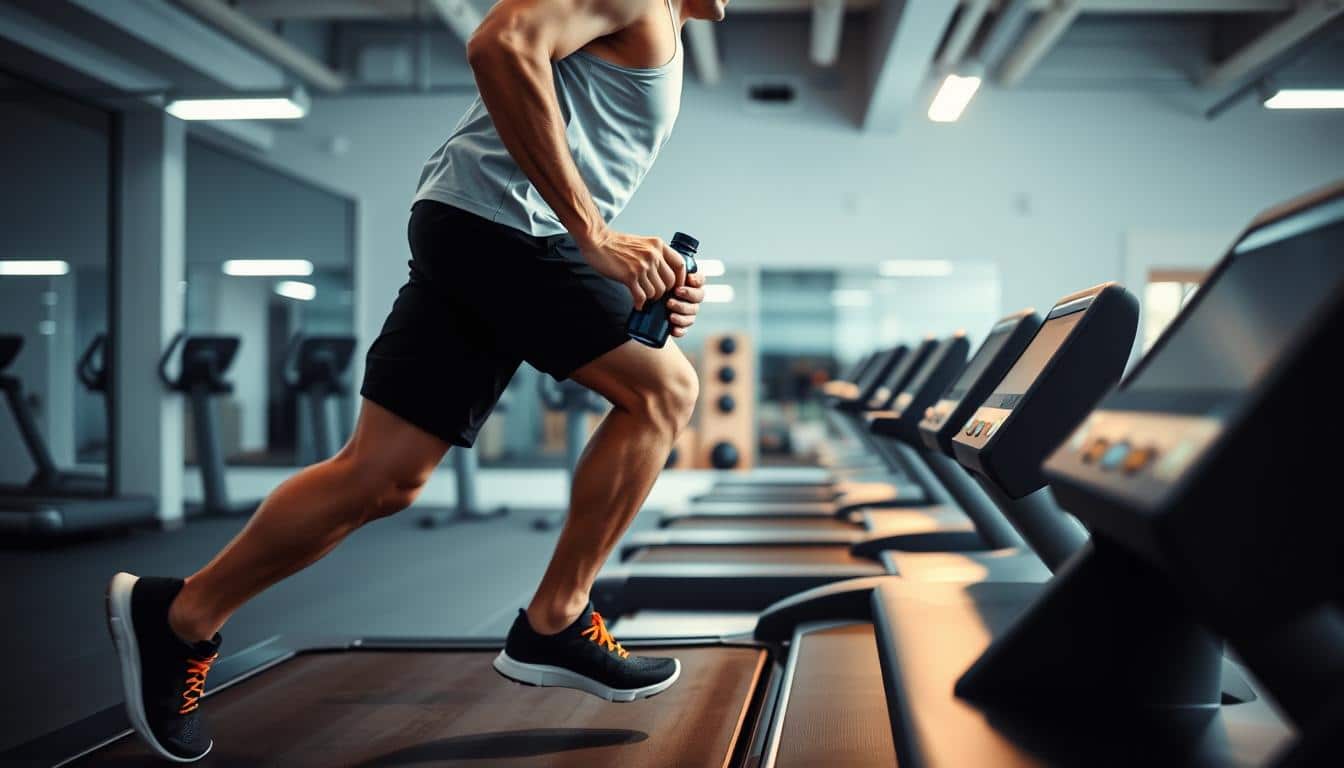Ever wonder why so many athletes rely on a little boost to power through their workouts? Research shows that over 73.8% of elite competitors trust it to improve their results. Whether you’re aiming for better endurance, strength, or focus, this natural aid has become a game-changer.
The International Society of Sports Nutrition (ISSN) recommends a safe dose of 3-6 mg/kg for optimal benefits. This systematic review meta-analysis highlights its effectiveness while emphasizing a safety-first approach. If you’re new to it, starting small can help you unlock its potential without overdoing it.
Ready to learn how it can elevate your game? Let’s dive into the science-backed strategies to maximize your results safely and effectively.
What is Caffeine and How Does It Work?
What’s the secret behind that extra kick you feel after your favorite drink? It all comes down to a natural compound called 1,3,7-trimethylxanthine. This is the scientific name for caffeine, and it’s what gives you that boost.

Once consumed, caffeine is quickly absorbed into your bloodstream. About 96% of it is metabolized by an enzyme produced by the CYP1A2 gene. This process varies from person to person, which is why some people feel effects faster than others.
The Science Behind Caffeine
Caffeine works by blocking adenosine receptors in your central nervous system. Adenosine is a chemical that makes you feel tired. By blocking it, caffeine keeps you alert and focused.
The speed of its effects depends on how you take it. For example, coffee hits your system in about 30 minutes, while capsules can take up to an hour. This difference is crucial for timing your intake.
How Caffeine Affects the Body
Immediate effects include increased alertness and energy. Over time, it can also improve your caffeine exercise performance by delaying fatigue and enhancing focus.
However, the way your body processes caffeine depends on factors like genetics and habits. Understanding this can help you use it more effectively to meet your goals.
Benefits of Caffeine for Athletes
Looking for a way to push your limits during workouts? Here’s how a natural boost can help. Whether you’re a runner, cyclist, or weightlifter, this compound has been shown to enhance results across the board.
Improved Endurance Performance
Studies reveal that this natural aid can significantly improve endurance performance. For example, cyclists in a 40km trial saw a 21% reduction in their times. This is partly due to its ability to spare glycogen, allowing your body to use energy more efficiently during long activities like marathons.
Triathletes also benefit, with one case study showing a 4% boost in overall performance. This makes it a valuable tool for anyone looking to go the extra mile—literally.
Enhanced Strength and Power
When it comes to resistance exercise, this compound can help you lift 2-7% more weight. Men, in particular, tend to see greater gains, with research showing a 57% higher power output compared to women.
This ergogenic effect caffeine provides is especially useful for activities requiring bursts of strength, like sprinting or powerlifting. It’s a game-changer for those aiming to maximize their potential.
Caffeine Use in Sports Performance
Curious about how athletes get that extra edge during intense training? Many rely on carefully timed caffeine supplementation to stay sharp and energized. Whether it’s gum, pills, or drinks, the key is choosing the right product for your needs.
How Athletes Use Caffeine
Timing is everything. For example, chewing gum reaches peak absorption in just 42 minutes, making it a favorite for quick results. Capsules, on the other hand, take about 67 minutes to kick in. This difference can be crucial for pre-workout planning.
Gels are another popular option, with a 95% absorption rate. They’re ideal for athletes who need a fast, portable solution. Tablets are effective but may take longer to feel the effects.
Types of Caffeine Products for Athletes
Here’s a quick comparison of popular products and their absorption rates:
| Product | Peak Absorption Time |
|---|---|
| Chewing Gum | 42 minutes |
| Capsules | 67 minutes |
| Energy Drinks | 30-45 minutes |
While energy drinks are convenient, watch out for their sugar content. Too much sugar can lead to energy crashes, which is the last thing you want during a workout.
An NCAA runner shared her protocol: she uses gum during relays for a quick boost without the hassle of carrying drinks. It’s a smart strategy for staying focused and energized.
Mechanisms of Caffeine’s Ergogenic Effects
Ever wondered how your body responds to that extra push during intense workouts? The answer lies in the way this natural compound interacts with your systems. From masking fatigue to enhancing muscle function, the effects are both fascinating and powerful.
Impact on the Central Nervous System
Your central nervous system plays a key role in how you feel during exercise. This compound blocks adenosine receptors, which are responsible for signaling fatigue. By doing so, it keeps you alert and focused, even when your body is tired.
Studies show it can reduce perceived exertion by up to 33%. This means you feel less pain and can push harder during activities like sprints or heavy lifts. Powerlifters often report higher pain tolerance, allowing them to perform at their best.
Effects on Muscle Contraction
Muscle function also gets a boost. This compound increases calcium release in muscle cells, which is essential for contraction. The more efficiently your muscles contract, the stronger and more powerful your movements become.
Another key player is the sodium-potassium pump. This mechanism helps maintain muscle cell stability, preventing cramps and improving endurance. Together, these effects make it easier to sustain high-intensity efforts.
| Mechanism | Effect |
|---|---|
| Central Nervous System | Reduces fatigue signals, improves focus |
| Calcium Release | Enhances muscle contraction |
| Sodium-Potassium Pump | Stabilizes muscle cells, prevents cramps |
Optimal Dosage for Athletic Performance
Finding the perfect amount to fuel your performance can be tricky. Too little, and you might not feel the effects. Too much, and you could end up with jitters or worse. Let’s break down the science to help you get it just right.
Recommended Caffeine Doses
Research shows that moderate doses caffeine can significantly improve your results. For example, a dose of 3 mg/kg has been shown to enhance 40km time trials by 3.1%. This is a great starting point for most athletes.
Here’s a weight-based chart to help you calculate your ideal amount:
| Weight (lbs/kg) | Recommended Dose (mg) |
|---|---|
| 150 lbs / 68 kg | 204 mg |
| 180 lbs / 82 kg | 246 mg |
| 200 lbs / 91 kg | 273 mg |
Cyclists and weightlifters may need slightly different amounts. Cyclists often benefit from higher doses for endurance, while weightlifters may prefer smaller amounts for focus.
Risks of High Doses
While doses caffeine can be helpful, going overboard can backfire. Taking 9 mg/kg or more may cause jitters, nausea, or even heart palpitations. Here are five common symptoms of overconsumption:
- Increased heart rate
- Anxiety or restlessness
- Headaches
- Digestive issues
- Insomnia
The NCAA sets a urine limit of 15μg/ml to ensure safe use. Always test your tolerance before race day to avoid surprises.
By sticking to moderate doses caffeine, you can enjoy the benefits without the risks. Start low, monitor your response, and adjust as needed to find your sweet spot.
Timing Your Caffeine Intake
Timing can make or break your workout results. Whether you’re a marathoner or a sprinter, knowing when to take your boost is key to maximizing its benefits. Let’s dive into the best strategies to align your intake with your goals.
When to Take Caffeine for Best Results
For most athletes, taking it 60 minutes before exercise is the standard. This allows enough time for acute caffeine ingestion to kick in. However, if you’re using gum, it can work in as little as 15 minutes, making it ideal for quick bursts of energy.
Marathoners often plan their intake around their race schedule, while sprinters might prefer a faster-acting option like gum or gels. Tailoring your approach to your activity can make a big difference.
Pre-Workout vs. During Exercise
Pre-workout intake is great for building energy before you start. But sipping small amounts during your session can help maintain focus and endurance. This intra-workout strategy is especially useful for long-distance athletes.
Tour de France riders, for example, follow a 3-stage protocol: pre-race, mid-race, and final push. This ensures they stay sharp throughout the competition.
Be cautious with late-day use, though. It can disrupt your sleep, which is crucial for recovery. Always consider your body’s half-life, which varies based on genetics. A simple calculator can help you plan your intake without affecting your rest.
Caffeine and Aerobic Exercise
Ever thought about how a small boost can transform your endurance? Aerobic activities like running and cycling often demand sustained energy, and research shows that a strategic approach can make a big difference. Let’s explore how it benefits endurance athletes and what studies reveal about its impact.
Benefits for Endurance Athletes
For those who thrive on long-distance challenges, this natural aid can be a game-changer. Studies highlight a 4.2% improvement in 10km run times with a 5mg/kg dose. This is due to its ability to delay fatigue and enhance focus, allowing athletes to maintain their pace longer.
Here’s how it works:
- Improves glycogen sparing, conserving energy for longer efforts.
- Reduces perceived exertion, making tough workouts feel easier.
- Boosts mental clarity, helping you stay focused during endurance events.
Studies on Cycling and Running
Cyclists, in particular, see significant gains. A review of 12 studies found improvements of 3-6% in cycling time trial performance. This makes it a popular choice for events like the Tour de France, where every second counts.
Marathoners also benefit. Nutritionists recommend pairing it with proper hydration to maximize results. For example, gels are often preferred over coffee during ultras for their quick absorption and portability.
One Ironman champion shared his strategy: he uses a combination of gels and gum to maintain energy levels throughout the race. This approach ensures a steady release of energy without overwhelming the system.
Remember, more isn’t always better. Higher doses can lead to jitters or digestive issues, which can derail your performance. Stick to moderate amounts and test your tolerance during training to find what works best for you.
Caffeine and Anaerobic Exercise
Ever wondered how a quick boost can enhance your explosive power? When it comes to activities like sprinting and powerlifting, timing and dosage play a crucial role. Let’s explore how it impacts these high-intensity efforts and why responses vary between men and women.
Impact on Sprinting and Powerlifting
For sprinters, even a small dose can lead to a 5% improvement in vertical jump height. This is due to its ability to enhance muscle contraction and increase energy availability. Powerlifters also benefit, with studies showing a noticeable boost in bench press performance.
However, the effects aren’t the same for everyone. Research from Sabblah (2015) found that women experience a 57% lower power boost compared to men. This difference highlights the importance of tailoring your approach based on individual needs.
Differences Between Men and Women
Several factors contribute to the varying responses. Hormonal fluctuations during the menstrual cycle can influence how women process it. For example, some women may feel more effects during the follicular phase than the luteal phase.
On the other hand, men often experience a synergy between testosterone and this compound, which can amplify its benefits. Olympic lifters, for instance, often adjust their competition doses to maximize these effects.
Here’s a quick breakdown of key differences:
- Women: Lower power boost, influenced by menstrual cycle.
- Men: Greater power output, enhanced by testosterone synergy.
- Both: Improved focus and energy for resistance exercise.
Understanding these nuances can help you optimize your strategy for better results. Whether you’re aiming for a personal best or preparing for competition, knowing how your body responds is key.
Caffeine and Cognitive Function
How does a small boost sharpen your mental edge during training? Beyond physical benefits, it plays a key role in keeping your mind sharp and focused. Whether you’re aiming for better reaction times or improved alertness, understanding its impact on your brain can take your game to the next level.
Improved Focus and Alertness
Research shows that a dose of 200mg can improve reaction time by 12%, especially when you’re tired. This is why many athletes rely on it during high-pressure moments. For example, NFL combine participants often see better test results when they’re alert and focused.
Focus-intensive activities like archery and shooting also benefit. These sports demand precision, and a mental boost can make all the difference. Morning training sessions, in particular, show significant improvements when paired with the right timing.
Effects Under Sleep Deprivation
When you’re short on rest, it can help bridge the gap. Studies reveal that it reduces the impact of sleep deprivation, keeping you functional even when you’re exhausted. This is especially useful for 24-hour races, where staying alert is crucial.
However, relying on it too often can lead to dependency cycles. Over time, your body may build tolerance, requiring higher doses for the same effect. To avoid this, use it strategically and prioritize proper rest whenever possible.
Here’s a quick tip: Pair it with a balanced nutrition plan during long events. This ensures sustained energy without overloading your system.
Caffeine Sources for Athletes
What’s the best way to fuel your workout with a quick boost? Athletes have plenty of options, but not all are created equal. Let’s break down the most popular choices to help you find what works best for your routine.
Comparing Coffee and Energy Drinks
Coffee is a classic choice for many. It’s natural, widely available, and easy to customize. A standard cup contains about 95mg of caffeine, making it a reliable option for sustained energy. Plus, it’s a great way to start your day before hitting the gym.
On the other hand, energy drinks offer convenience and portability. They often contain added vitamins and electrolytes, which can be helpful during intense sessions. However, watch out for sugar content—too much can lead to energy crashes. Athletes often rate brands like Red Bull and Monster highly for their effectiveness.
Chewing Gum and Other Alternatives
If you’re looking for something fast-acting, chewing gum might be your best bet. It provides 65% faster absorption compared to other forms, making it ideal for quick boosts. Olympic swimmers, for example, often use gum during competitions for its portability and efficiency.
Other travel-friendly options include gels and tablets. Gels are great for endurance athletes, while tablets offer a controlled dose. Here’s a quick comparison of popular sources:
- Coffee: 95mg per cup, slow absorption.
- Energy Drinks: 80-160mg per can, moderate absorption.
- Chewing Gum: 40-100mg per piece, fast absorption.
Understanding these options can help you tailor your intake to your specific needs. Whether you’re a runner, cyclist, or weightlifter, there’s a source that fits your routine.
Legal Status of Caffeine in Sports
Understanding the rules around supplements can help you stay on top of your game. Whether you’re a pro athlete or a weekend warrior, knowing what’s allowed and what’s not is crucial. Let’s break down the key regulations and how they impact your routine.
WADA and NCAA Regulations
The World Anti-Doping Agency (WADA) no longer lists this compound as a banned substance. However, it’s still monitored to prevent misuse. The NCAA, on the other hand, sets a urine limit of 15μg/ml, which equals about a 500mg dose. Staying within this limit ensures you’re compliant and safe.
Here’s a quick guide to practical dosing based on weight:
| Weight (lbs/kg) | Max Safe Dose (mg) |
|---|---|
| 150 lbs / 68 kg | 204 mg |
| 180 lbs / 82 kg | 246 mg |
| 200 lbs / 91 kg | 273 mg |
Monitoring in Competitions
Urine testing is a common method to check for compliance. Factors like hydration and metabolism can affect concentration levels. For example, a 2015 case study showed an athlete exceeding the limit due to high intake before a race. This highlights the importance of timing and moderation.
Sports like cycling and triathlon see the highest usage rates. Athletes in these disciplines often rely on it for endurance and focus. However, it’s essential to plan your intake to avoid crossing the threshold.
Here’s a simple tip: Use a 72-hour clearance calculator to estimate how long it stays in your system. This tool can help you plan your intake without risking disqualification.
Side Effects and Risks of Caffeine
Have you ever felt a little off after that extra cup of coffee? While it can give you a boost, too much can lead to unwanted side effects. Knowing what to watch for and how to manage risks can help you stay on track without compromising your health.
Common Side Effects
Taking more than 9mg/kg increases the chance of side effects by 89%. Here are some symptoms to look out for:
- Jitters or restlessness
- Increased heart rate
- Headaches
- Digestive issues
- Anxiety or nervousness
- Insomnia
- Dizziness
- Dehydration
- Muscle tremors
- Arrhythmia (irregular heartbeat)
If you experience any of these, it’s a sign to cut back. Staying hydrated is key—aim for at least 8 glasses of water daily to balance your intake.
How to Avoid Negative Outcomes
Managing risks starts with understanding your body’s limits. Here’s a simple protocol to reset your tolerance:
- Take a 7-day break to reset your system.
- Start with a low dose and gradually increase if needed.
- Monitor how you feel and adjust accordingly.
Body weight also plays a role. Here’s a comparison of sensitivities based on weight:
| Weight (lbs/kg) | Recommended Daily Limit (mg) |
|---|---|
| 150 lbs / 68 kg | 204 mg |
| 180 lbs / 82 kg | 246 mg |
| 200 lbs / 91 kg | 273 mg |
If you’re unsure, consult a healthcare professional. They can help you create a personalized plan for safe use. By staying informed and proactive, you can enjoy the benefits without the downsides.
Individual Responses to Caffeine
Why do some people feel energized after a cup of coffee while others feel nothing? The answer lies in your genes and habits. Your body’s response depends on factors like metabolism and how often you consume it. Let’s break down what makes your experience unique.
Genetic Factors and Metabolism
Your CYP1A2 gene plays a big role in how quickly your body processes this compound. If you have the AA genotype, you’re a fast metabolizer—your body breaks it down 40% faster than others. This means you might feel the effects quickly but also lose them sooner.
On the other hand, slow metabolizers may feel jittery or anxious even with small amounts. The ADORA2A receptor also influences how you respond. Some people are more sensitive to its effects, while others barely notice a difference.
Curious about your genes? A 23andMe report can reveal whether you’re a fast or slow metabolizer. This knowledge can help you tailor your intake for better results.
Habitual Use and Tolerance
If you’re a daily drinker, your body may have built up a tolerance. This means you need more to feel the same effects. Occasional users, on the other hand, often feel a stronger impact with smaller doses.
Here’s a simple 2-week reset protocol to reverse tolerance:
- Take a break for 7 days to reset your system.
- Start with a low dose and gradually increase if needed.
- Monitor how you feel and adjust accordingly.
By understanding your body’s unique response, you can make smarter choices. Whether you’re a fast metabolizer or a daily drinker, there’s a strategy that works for you.
Caffeine and Recovery
Want to know how to bounce back faster after a tough workout? Recovery is just as important as the workout itself, and a little boost can make a big difference. Let’s explore how it helps your muscles recover and why timing matters.
Effects on Muscle Recovery
After intense exercise, your muscles need fuel to repair and grow. Studies show that taking 8mg/kg post-workout can boost glycogen resynthesis by 66%. This means your body replenishes energy stores faster, helping you recover quicker.
Here’s how it works:
- Enhances nutrient absorption, speeding up muscle repair.
- Reduces inflammation, easing soreness after exercise.
- Improves focus, helping you stick to your recovery routine.
Post-Exercise Caffeine Use
Timing is key. Taking it after your workout can be just as effective as pre-workout. A rugby team case study found that players who used it post-training recovered faster and performed better in their next session.
For best results, pair it with carbs and protein. This combo maximizes recovery by providing the nutrients your muscles need. Here’s an ideal post-workout mix:
- A banana and a protein shake.
- Greek yogurt with berries.
- Whole grain toast with peanut butter.
Be cautious with cortisol levels. High doses can spike stress hormones, which may slow recovery. Stick to moderate amounts to avoid this issue.
To reduce delayed onset muscle soreness (DOMS), try this simple protocol:
- Take a dose within 30 minutes post-workout.
- Stay hydrated to flush out toxins.
- Stretch or use a foam roller to relax muscles.
By incorporating these strategies, you can recover faster and get back to training stronger than ever.
Practical Tips for Athletes
Ready to take your training to the next level with a simple yet effective strategy? Whether you’re a runner, cyclist, or weightlifter, incorporating this natural aid can make a big difference. Let’s dive into actionable tips to help you get the most out of your routine.
How to Incorporate It Safely
For 85% of athletes, a dose of 3mg/kg works wonders. Start with this amount and adjust based on your body’s response. Here’s a quick guide to sport-specific dosing:
| Sport | Recommended Dose (mg/kg) |
|---|---|
| Cycling | 3-5 |
| Running | 3-4 |
| Weightlifting | 2-3 |
Cross-country skiers often follow a winter plan that includes a pre-race dose and small amounts during long sessions. This helps maintain energy without overloading the system.
Best Practices for Different Sports
Here are some best practices tailored to your activity:
- Cycling: Take it 60 minutes before a race for sustained energy.
- Running: Use gels or gum for quick absorption during marathons.
- Weightlifting: Smaller doses can improve focus without causing jitters.
Pro athletes swear by these hacks:
- Pair it with carbs for better absorption.
- Stay hydrated to avoid side effects.
- Test your tolerance during training, not on race day.
Try this 4-week trial protocol to find your sweet spot:
- Week 1: Start with 2mg/kg and monitor your response.
- Week 2: Increase to 3mg/kg if needed.
- Week 3: Test timing—pre-workout vs. during exercise.
- Week 4: Adjust based on your performance and comfort.
By following these sport-specific tips, you can optimize your routine and achieve your goals safely. Remember, moderation is key to avoiding unwanted side effects.
Conclusion
When it comes to optimizing your routine, finding the right balance is key. Research suggests a sweet spot of 3-6mg/kg for most individuals. This range helps maximize benefits while minimizing risks. However, everyone’s body is different, so personal experimentation is essential.
Don’t fall into the trap of copycat dosing. What works for someone else might not work for you. Start with a lower dose and gradually increase it to find your ideal amount. This approach helps you avoid unwanted side effects and ensures a smoother transition.
Finally, keep safety in mind. Always monitor how your body responds and stay within recommended limits. By taking a thoughtful, gradual approach, you can unlock the full potential of your efforts without compromising your health.


